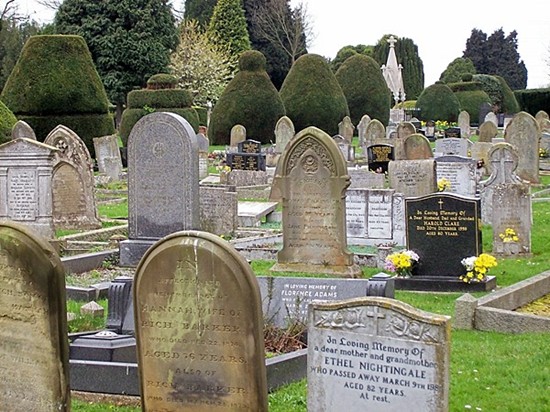|
- The market town of Bourne, Lincolnshire, England - |
The town cemetery

|
- The market town of Bourne, Lincolnshire, England - |

|
BURIALS IN THE CHURCHYARD of the Abbey Church ended during the mid-19th century with the opening of the town cemetery. The Bourne Burial Board purchased four acres of land in South Road in 1854 for £420 from Sir Philip Pauncefort Duncombe, Lord of the Manor of Bourne Abbots, and it was freed from its manorial ties as a result of the purchase. The cemetery was opened in June 1855 and stone markers bearing that date were erected around the boundaries of the site. In 1904, it was extended up to 5½ acres and in 1999 when land for further burial plots was exhausted, another two acres were added beyond the brick wall and this is known today as the new cemetery. Ornamental iron railings in black and gold have been added to the low wall fronting the road although the lodge built for the cemetery supervisor was dismantled in 1960 and replaced by a modern bungalow, now used as offices. The remains of over 10,000 people are buried in the cemetery which is administered by Bourne Town Council and contains an interesting mix of headstones and memorials, the early ones in stone and slate while black, white, red and grey marble and polished granite predominate for later burials. The wording on many of the stone memorials, especially those from the 19th century, has been eroded by wind and weather but a local record of those who are buried here is kept by the cemetery supervisor while a more detailed compilation exists on computer at the county records office in Lincoln. A stone chapel built for pre-burial services when the cemetery was opened has recently been listed Grade II to prevent the town council from pulling it down and the newly formed Bourne Preservation Society hopes to take over the building and restore it for further use. There is also a rose garden and a garden of remembrance for those who were cremated together with a large number of memorial seats, rose bushes, trees and shrubs marked with dedication plaques while the paths that crisscross the grounds are lined with well trimmed holly and yew trees and an occasional conifer with laurels around the boundary. Maintenance work in recent years has been of a particularly high standard and has resulted in two successes on the Cemetery of the Year awards, in 2002 and again in 2006, and engraved and gilt-lettered plaques have been erected at the entrance to the grounds to mark these achievements.
An illustrated history of the cemetery and details of many of those who are
buried there Return to HOME PAGE MAIN INDEX
|